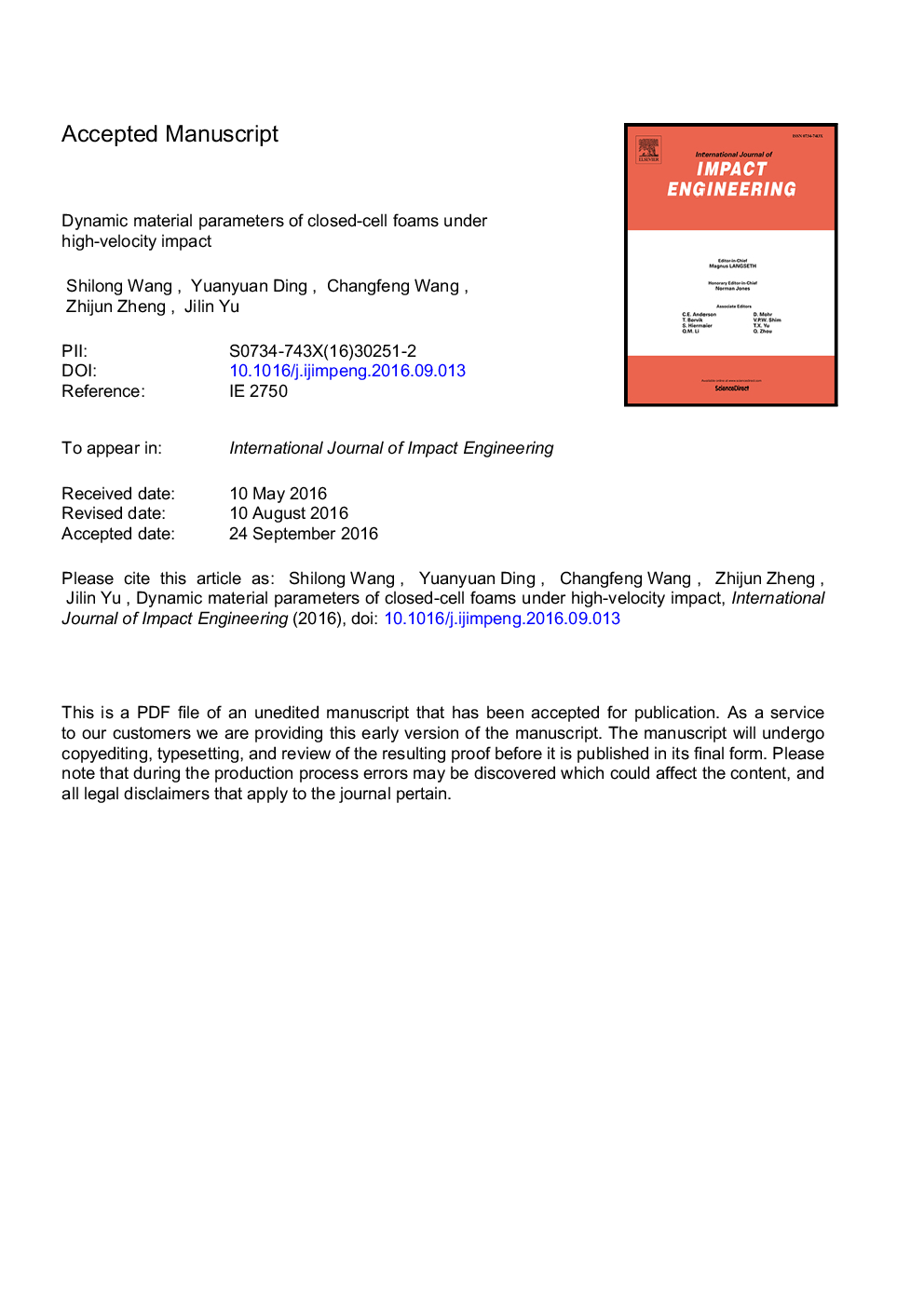| کد مقاله | کد نشریه | سال انتشار | مقاله انگلیسی | نسخه تمام متن |
|---|---|---|---|---|
| 5015659 | 1464052 | 2017 | 34 صفحه PDF | دانلود رایگان |
عنوان انگلیسی مقاله ISI
Dynamic material parameters of closed-cell foams under high-velocity impact
ترجمه فارسی عنوان
پارامترهای مواد پویای فوم بسته های سلولی تحت تاثیر سرعت بالا
دانلود مقاله + سفارش ترجمه
دانلود مقاله ISI انگلیسی
رایگان برای ایرانیان
کلمات کلیدی
فوم بسته به سلول، تجزیه و تحلیل عنصر محدود، میدان سرعت موج شوک، تجزیه و تحلیل ابعادی،
ترجمه چکیده
مواد سلولی تحت تأثیر با سرعت بالا، تغییر شکل بسیار موضعی را با فروپاشی لایه سلولی سلول، که معمولا توسط انتشار موج ضربه مشخص می شود، دارد. تحقیقات نشان داده اند که سرعت موج شوک به شدت وابسته به سرعت ضربه است، اما اثر پارامترهای مزو-ساختاری و پایه مواد نامشخص است. در این مطالعه پارامترهای مواد پویای فوم بسته های سلولی با مدل های عنصر محدودی مبتنی بر سلول مورد بررسی قرار گرفته است. توزیع سرعت یک بعدی در امتداد جهت بارگیری برای تسخیر انتشار جبهه شوک استفاده می شود. بنابراین سرعت موج شوک تعیین می شود و اگر سرعت ضربه به اندازه کافی بالا باشد، رابطه ی خطی با سرعت ضربه نشان داده می شود. تفاوت سرعت موج شوک و سرعت ضربه یک پارامتر مواد مواد سلولی است و اثر پارامترهای مزوموریتی و پایه مواد بر روی این پارامتر مواد ماتریس با تحلیل ابعادی بررسی شده است. بیان پارامتر مواد پویا با توجه به تراکم نسبی و پارامترهای مواد پایه بدست می آید. این نشان می دهد که پارامتر مواد پویا به شدت بر تراکم نسبی متکی است و به صورت خطی با تراکم نسبی افزایش می یابد. بررسی تنش های دینامیکی با کمک یک مدل شوک نشان می دهد که تنش خرد شدن اولیه در یک گرایش قدرت قانون با افزایش تراکم نسبی افزایش می یابد. در نتیجه، یک رابطه تنش-تنش با توجه به تراکم نسبی سلول مواد و تنش عملکرد و تراکم مواد پایه برای فومهای بسته شده در نظر گرفته شده است. اثرات رفتارهای سخت کننده مواد دیوار سلولی و گاز موجود در سلول ها نیز در نظر گرفته می شود. یافته شده است که پارامتر مواد پویا افزایش تقریبا خطی با افزایش پارامترهای سخت شدن مواد پایه و فشار گاز اولیه است، در حالی که تنش اولیه خرد شدن اولیه به طور مستقل از پارامتر خمش کشش و فشار گاز بستگی دارد اما با فشار پارامتر تشدید سختی خطی. این یافته ها ممکن است برای هدایت طراحی مقاوم در برابر مصالح مواد و سازه های سلولی مفید باشد.
موضوعات مرتبط
مهندسی و علوم پایه
سایر رشته های مهندسی
مهندسی مکانیک
چکیده انگلیسی
Cellular materials under high-velocity impact have highly localized deformation with the cells layer-wise collapse, which is usually characterized by the propagation of shock wave. Researches have shown that the shock wave speed is strongly dependent on the impact velocity, but the effect of the meso-structural and base-material parameters is unclear. In this study, the dynamic material parameters of closed-cell foams are investigated with cell-based finite element models. The one-dimensional velocity distribution along the loading direction is used to capture the propagation of shock front. The shock wave speed is thus determined and it exhibits a linear relationship with impact velocity when the impact velocity is high enough. The difference between the shock wave speed and the impact velocity is a dynamic material parameter of cellular material and the effect of meso-structural and base-material parameters on this dynamic material parameter is investigated with dimensional analysis. An expression of the dynamic material parameter with respect to the relative density and the base-material parameters is obtained. It shows that the dynamic material parameter intensively relies on the relative density and increases linearly with the relative density. The investigation of dynamic stresses with the aid of a shock model shows that the initial crushing stress increases in a power-law tendency with the increase of relative density. As a result, a stress-strain relation involving the relative density of material cellular and the yield stress and density of base material is obtained for the closed-cell foams considered. The effects of hardening behaviors of cell-wall material and gas trapped within cells are also considered. It is found that the dynamic material parameter exhibits nearly linear increase with the increase of hardening parameters of base material and initial gas pressure, while the dynamic initial crushing stress is independent of the strain-hardening parameter and the entrapped gas pressure but increases with the strain-rate hardening parameter linearly. These findings may be helpful for guiding the crashworthiness design of cellular materials and structures.
ناشر
Database: Elsevier - ScienceDirect (ساینس دایرکت)
Journal: International Journal of Impact Engineering - Volume 99, January 2017, Pages 111-121
Journal: International Journal of Impact Engineering - Volume 99, January 2017, Pages 111-121
نویسندگان
Wang Shilong, Ding Yuanyuan, Wang Changfeng, Zheng Zhijun, Yu Jilin,
